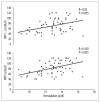Respiratory pressures and expiratory peak flow rate of patients undergoing coronary artery bypass graft surgery
- PMID: 22936191
- PMCID: PMC3560654
- DOI: 10.12659/msm.883351
Respiratory pressures and expiratory peak flow rate of patients undergoing coronary artery bypass graft surgery
Abstract
Background: To evaluate clinical and laboratorial parameters that predict decreased respiratory function in patients subjected to coronary artery bypass graft surgery (CABG).
Material/methods: This was a prospective study evaluating 61 patients subjected to CABG with cardiopulmonary bypass, median sternotomy, and under mechanical ventilation for up to 24 h. One day before surgery, clinical information was recorded. Maximal inspiratory (MIP) and expiratory (MEP) pressures, and expiratory peak flow rate (EPFR) values were assessed 1 day before surgery and on the fifth postoperative day. Student's t test, 2-way ANOVA, Pearson's linear correlation, and logistic regression were used for statistical analysis.
Results: Patients were 63±10 years old, 67% males. Arterial hypertension was found in 75.4% of the patients, diabetes in 31.2%, dyslipidemia in 63.9%, tabagism in 25%, and chronic obstructive pulmonary disease (COPD) in 16.4%. Previous myocardial infarction was found in 67%. Preoperative hemoglobin levels were 12.8±1.71 g/dL. Older individuals had lower preoperative MEP and EPFR values. Preoperatively, positive association was found between hemoglobin levels and maximal respiratory pressures and EPFR values. Patients with both class III angina and COPD presented higher reductions in pulmonary pressures between the preoperative period and the 5th postoperative day.
Conclusions: Older age and low hemoglobin levels are associated with preoperative low maximal respiratory pressures and EPFR. The combination of severe angina and COPD results in higher postoperative reduction of maximal respiratory pressures for patients who underwent CABG.
Figures
References
-
- Eagle KA, Guyton RA, Davidoff R, et al. ACC/AHA 2004 guideline update for coronary artery bypass graft surgery: a report of the American College of Cardiology/American Heart Association Task Force on Practice Guidelines. Circulation. 2004;110:e340–437. - PubMed
-
- Chilappa K, Aronow WS, Rajdev A, et al. Mortality at long-term follow-up of patients with no, nonobstructive, and revascularized 1-, 2-, and 3-vessel obstructive coronary artery disease. Med Sci Monit. 2010;16(5):RA120–23. - PubMed
-
- Mansencal N, Pillière R, Gueta RN, et al. Characteristics and prognosis of coronary revascularization procedure in patients age 80 and older presenting with acute myocardial infarction. Med Sci Monit. 2010;16(1):CR15–20. - PubMed
-
- Pereira EDB, Fernandes ALG, Anção MDS, et al. Prospective assessment of the risk of postoperative pulmonary complications in patients submitted to upper abdominal surgery. Sao Paulo Med J. 1999;117:151–60. - PubMed
Publication types
MeSH terms
Substances
LinkOut - more resources
Full Text Sources
Medical


